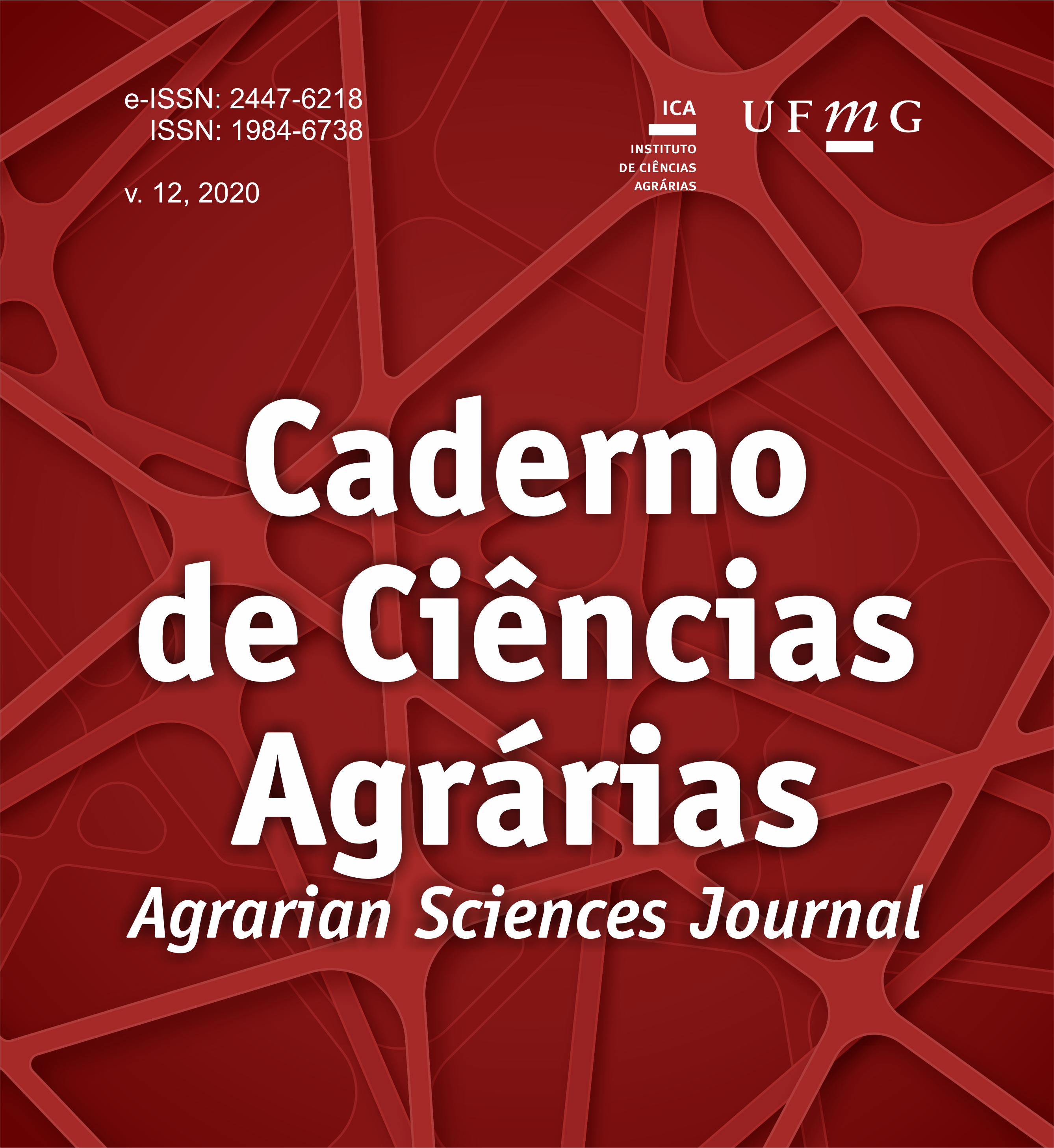Water erosion estimate in Belem Stream Watershed in Minas Gerais state
DOI:
https://doi.org/10.35699/2447-6218.2020.16213Keywords:
Soil conservation, Erosion Potential Method, Agricole sustainabilityAbstract
Water erosion causes a diversity of negative environmental impacts, provoking soil degradation and by consequence the agricole production decrease. Due to the damage caused by the soil erosion process, were developed a diversity of water erosion modeling methods in other to support in other to project and implement measures soil conservation. Among the models, the more useful is the Erosion Potential Method (EPM), which recently was adapted to the brazilian tropical conditions. In this context, the objective of this work was estimating the soil loss by Erosion Potential Method in a water basin located in Muzambinho, in the South of Minas Gerais. The EPM model estimated the water erosion in this study area starting with climate, topographic, pedology, land use, and erosive features degree parameters. The modeling stage and the parameters obtaining was done with the Geography Information System and remote sensing help. The total soil loss estimated by the EPM model was 10,418.53 Mg year-1, of which 5.50% reaches the water resources directly contributing to the siltation and water quality depreciation. The higher slope areas and the rural roads with exposed soil are where localize the biggest soil loss degrees. The modeling application was giving up in a simple and fast form, provender satisfactory results that are useful to the planning of soil conservation practices in the water basin.
Downloads
References
Alvares, C. A.; Stape, J. L.; Sentelhas, P. C.; Gonçalves, J. L. M.; Sparovek, G. 2013. Köppen’s climate classification map for Brazil. Meteorologische Zeitschrift, 22:711-728. https://doi.org/10.1127/0941-2948/2013/0507.
Avanzi, J. C.; Silva, M. L. N.; Curi, N.; Norton, L. D.; Beskow, S.; Martins, S. G. 2013. Spatial distribution of water erosion risk in a watershed with eucalyptus and Atlantic Forest. Ciência e Agrotecnologia, 37:427 434. https://doi.org/10.1590/S1413-70542013000500006.
Beskow, S.; Mello, C. R.; Norton, L. D.; Curi, N.; Viola, M. R.; Avanzi, J. C. 2009. Soil erosion prediction in the Grande River Basin, Brazil using distributed modeling. Catena, 79:49-59. https://doi.org/10.1016/j.catena.2009.05.010.
Efthimiou, N.; Lykoudi, E.; Karavitis, C. 2017. Comparative analysis of sediment yield estimations using different empirical soil erosion models. Hydrological Sciences Journal, 62:2674–2694. https://doi.org/10.1080/02626667.2017.1404068.
Environmental Systems Research Institute – ESRI. 2015. ARCGIS Professional GIS for the desktop version 10.3. Redlands, Califórnia, EUA, Software.
Gavrilovic, S. 1962. A method for estimating the average annual quantity of sediments according to the potency of erosion. Bulletin of the Faculty of Forestry, 26:151-168.
Google. Google Earth. Version 7.3.2.5776. 2019. Available in: http://www.google.com.br/earth/download/gep/agree.html.
Haghizadeh, A.; Shui, L. T.; Godarzi, E. 2009. Forecasting Sediment with Erosion Potential Method with Emphasis on Land Use Changes at Basin. Electronic Journal of Geotechnical Engineering, 14: 1-12.
Instituto Nacional de Pesquisas Espaciais - INPE. 2019. SGI 2.5 Divisão de Geração de Imagens (DIDGI). SGI. Imagem Geosistemas, São José dos Campos: Instituto Nacional de Pesquisas Espaciais. Available in: http://www.dgi.inpe.br/CDSR/.
Lense, G. H. E; Parreiras, T. C.; Moreira, R. S.; Avanzi, J. C.; Mincato, R. L. 2019. Estimates of soil losses by the erosion potential method in tropical latosols. Ciência e Agrotecnologia, 43:e012719. https://dx.doi.org/10.1590/1413-7054201943012719.
Miranda, E. E. 2005. Brasil em Relevo. Campinas: Embrapa Monitoramento por Satélite. Available in: http://www.relevobr.cnpm.embrapa.br.
Pandey, A.; Chowdary, V. M.; Mal, B. C. 2007. Identification of critical erosion prone areas in the small agricultural watershed using USLE, GIS and remote sensing. Water Resources Management, 21:729-746. https://doi.org/10.1007/s11269-006-9061-z.
Sakuno, N. R. R.; Guiçardi, A. C. F.; Spalevic, V.; Avanzi, J. C.; Silva, M. L. N.; Mincato, R. L. 2020 Adaptation and application of the erosion potential method for tropical soils. Revista Ciência Agronômica, 51:e20186545. https://dx.doi.org/10.5935/1806-6690.20200004.
Scharrón, C. E. R.; Sánchez, Y. F. 2017. Plot-, farm-, and watershed-scale effects of coffee cultivation in runoff and sediment production in western Puerto Rico. Journal of Environmental Management, 202:126-136. https://doi.org/10.1016/j.jenvman.2017.07.020.
Tavares, A. S.; Spalevic, V.; Avanzi, J. C.; Nogueira, D. A.; Silva, M. L. N.; Mincato, R. L. 2019. Modeling of water erosion by the erosion potential method in a pilot subbasin in southern Minas Gerais. Semin-Ciencias Agrárias, 40:555-572. https://doi.org/10.5433/1679-0359.2019v40n2p555.
Universidade Federal de Viçosa - UFV. 2010. Mapa de solos de Minas Gerais: legenda expandida. (1:650.000). Belo Horizonte: Fundação Estadual do Meio Ambiente / UFV / CETEC / UFLA / FEAM. Available in: http://www.dps.ufv.br/?page_id=742.
Zemljic, M. 1971. Calculation of sediment load. Evaluation of vegetation as anti-erosive factor. In: Proceedings of the international symposium Interpraevent, p.379-391.
Published
How to Cite
Issue
Section
License
Copyright (c) 2020 Agrarian Sciences Journal

This work is licensed under a Creative Commons Attribution 4.0 International License.
Authors who publish in this journal agree to the following terms:
The Copyright for articles published in this journal follow authorship. The articles are open access, with their own attributions, in educational and non-commercial applications.
The journal reserves the right to make regulatory, orthographic and grammatical changes in the originals, with the aim of maintaining the standard language and the credibility of the vehicle. It will respect, however, the writing style of the authors.
Changes, corrections or suggestions of conceptual order will be forwarded to the authors, when necessary. In such cases, the articles, once appropriate, should be submitted for further consideration.
The opinions issued by the authors of the articles are their sole responsibility.







